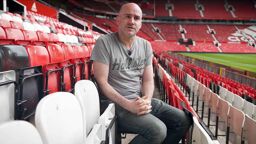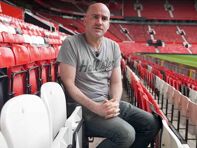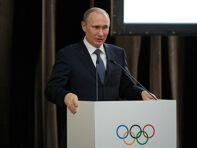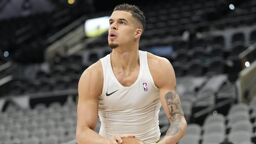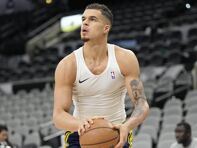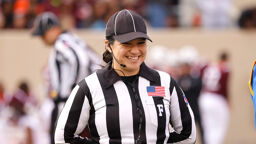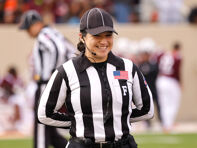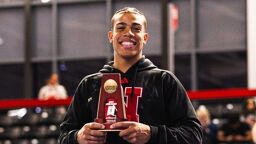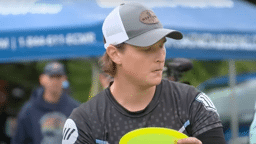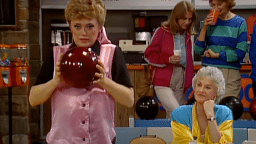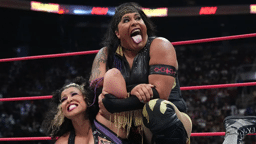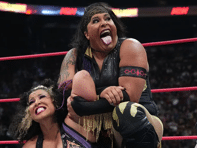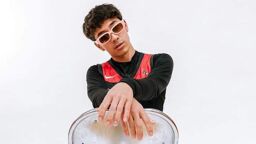Update Feb. 16: Finland beat Switzerland, 4-0, in the bronze medal game, with Ronja Savolainen playing over 27 minutes. It’s the team’s second consecutive Olympic bronze medal.
Original story: For out Olympic hockey player Ronja Savolainen, a hockey game on October 25, 2021, featured a split-second mix-up that became a potential nightmare.
One of best two-way defensemen in the international women’s game, Savolainen was closing out an early-season win for Luleå/MSSK, her club team and three-time defending Swedish Women’s Hockey League champion, when teammate Petra Numinen was clearing the puck.
Numinen looked up and saw Savolainen in front with her back turned to the speeding forward. Momentum and inertia made it impossible to avoid a collision. Both went down on the ice with Savolainen’s right ankle twisted underneath her teammate.
She was helped off the ice and sent to the hospital with a bruised knee and ligament damage to the ankle. While a lot of Finland held their breath over a key piece of their hopes for an Olympic medal, Savolainen was firm and focused.
“I’ve had a little time to rehabilitate my ankles,” she told the Finnish daily Iltalehti in November. “By the time of the Beijing Olympics, I should be fit to play.”
The doctors said she would be out six weeks. Exactly six weeks later Savolainen was back on the ice. By January she was playing both for her club team and in tune up games for Finland’s national team.
She pushed through one challenge to be ready for a steeper one in Beijing. Fans across Finland see these Olympics as a chance for their women’s hockey squad to break through the domination of the United States and Canada. The “Lady Lions” get their first chance in their Olympic opener against Team USA at 8:10amET Thursday.

Struggle And Progress for Savolainen
Breaking through barriers seems to be a personality trait for the aggressive player with a flashy superstar jersey number (Savolainen wears #88 in the ice), whom Finland’s second-largest newspaper dubbed a “happy energy bomb.” But her rise to being one of the best young players in the world was met with some early frustration.
She started playing hockey as a young girl in Helsinki, and she was a terror as a forward. At age 14 she attracted a lot of jealousy as a member of a high-level boys team where she was consistently the shining star.
“They started competing for real and they started talking bad about me behind my back,” she recalled to the Swedish sports newspaper Sportbladet. “They tried to make me not feel comfortable, so I would stop. ‘Girls should not play hockey’ and so on.”
Off the ice, she fought a different adversary. A battle waged at blackboards and in classrooms. When she was in third grade, she was diagnosed with ADHD and dyslexia.
“It was a pretty hard time,” she recalled in an interview with Finland’s Yleisradio. “I wondered why it was so difficult to learn such easy things. Things that should not be difficult. In the tests I could have difficulty understanding the questions themselves,”
Through the struggle in her school years she found support on the ice and off, from understanding teachers then and coaches, like her club team’s head coach Mikael Forsberg, now.
“In hockey, it is still about fairly short instructions, we draw and show, use different tools in our communication,” Forsberg sold Yleisradio. “But I understand that it can feel awkward with long videos and discussions. I still think Ronja solves it all in a good way.
The biggest catalyst in Savolainen going public with living with ADHD was her girlfriend of two years, Luleå teammate, and member of rival Sweden’s Olympic team for Beijing, Anna Kjellbin. At Kjellbin’s heeding, Savolainen has become a role model in speaking out, especially for young people with ADHD who made be struggling as she did growing up.
A leap forward by moving to the back
Ronja Savolainen was a score-first forward when she got her first call to play for Finland. By a quarterfinal game of the 2014 IIHF Women’s Under-18 World Championships against Russia, she was rotated to the position that would make her name today.
“I played as the defender of the last game of the tournament when two starters were injured,” she recalled to Iltalehti. “The coach praised me for being really good and suggested switching completely as a defender. I said thank you, no.”

She was selected for the national team in 2015, but her “thank you no” was denied. She was selected as a defender instead of an attacker.
She went from not wanting to play the position to building a reputation as one of the best at her position. Her rise also corresponds with the national team’s rise, and she was at the center of two large steps forward for Finland’s women’s national team in recent years.
At the 2017 World Championships in Plymouth, Mich., she scored the winning goal in the final minute for Finland’s first ever round-robin win over Canada. Two years later with the world championship tournament on home ice at Espoo, Finland, she flipped an empty-net wrist shot in the final seconds to eliminate Canada and sent Finland into a final match against the United States.
Finland lost a close one in the championship final 2-1, but that tournament solidified Savolainen as a player to watch, and gave Finland’s women their highest finish ever in a world championship tournament.
Savolainen and her team won Olympic bronze in Pyeongchang in 2018, and seeks to improve on that finish in Beijing. Even with Team USA and Team Canada as the first two games on the Olympic slate for Finland, don’t bet on Ronja Savolainen being fazed by the odds at all.
“It’s going to be exciting and this team has a lot to show,” Savolainen said as part of an IIHF Olympic Preview. “I know we have that energy to win every game. We just need to bring that out.”









